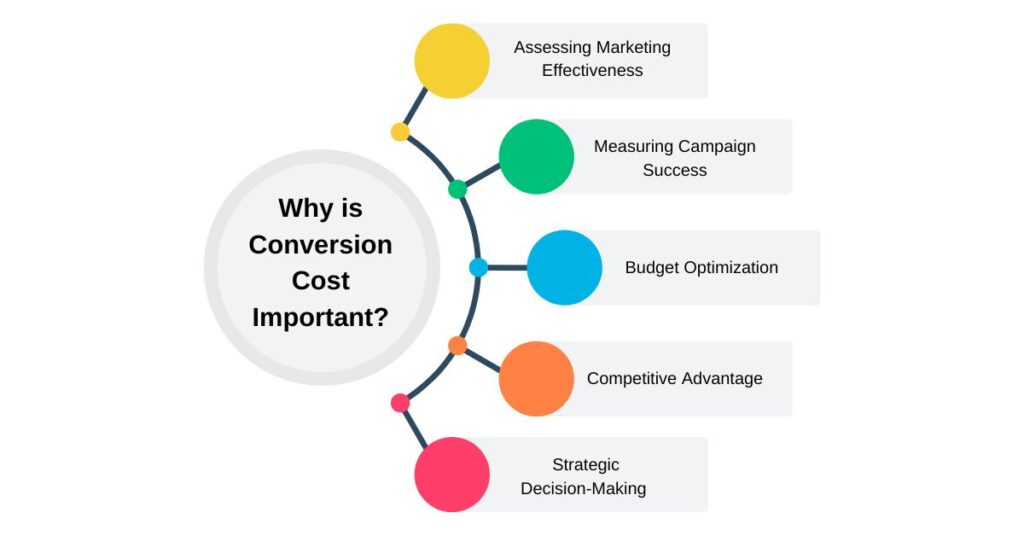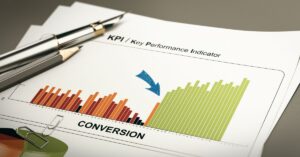Let’s face it – marketing isn’t cheap. Every click, every ad, and every email campaign comes with a price tag. But what if you could make your marketing budget work smarter, not harder? That’s exactly what mastering the cost of conversion allows you to do.
By getting a handle on this vital metric, you’ll be able to fine-tune your strategies, maximize your return on investment (ROI), and ultimately grow your business more efficiently.
So, let’s examine the details of conversion costs.
What is the Cost of Conversion?
The cost of conversion, or conversion cost, is the total amount of money you spend to convince a potential customer to take a desired action, such as completing a purchase or subscribing to a newsletter. This metric encompasses all expenses related to marketing efforts, including advertising, promotions, and any associated operational costs.
Understanding conversion costs is vital for businesses to evaluate the efficiency of their marketing strategies. Companies can determine which tactics yield the best results by analyzing these costs. Ultimately, keeping the cost of conversion low while maintaining high conversion rates is a sign of effective marketing.
Conversion Cost Analogy
Think of conversion costs like fishing. Your money spent on bait, fishing rods, and other gear is your investment; the fish you catch represent your conversions. Different fishing spots and bait types can affect your success, but various marketing channels and strategies can influence your conversion rates.
The goal is to find the perfect combination that yields the highest number of fish with the least expenditure. Similarly, businesses must experiment with different marketing approaches to identify the most cost-effective methods. The key is optimizing resources to maximize returns.
The goal of Conversion Cost
The objective is to catch as many fish as possible with the smallest investment. Similarly, marketing aims to achieve the highest conversions at the lowest cost.
This involves continuously refining and optimizing marketing campaigns to ensure they are as efficient as possible. By closely monitoring their cost of conversion, businesses can make informed decisions with regard to allocating their marketing budget.
The ultimate aim is to enhance the return on investment (ROI) by increasing conversions without proportionally increasing costs. Effective management of conversion costs can significantly impact a company’s bottom line and overall profitability.
Why is Conversion Cost Important?
Knowing your conversion cost helps you determine whether your marketing strategies are working. You should change your tactics if your expenses are high but your conversions are low. On the other hand, a low conversion cost with high conversions means you’re doing something right.

Assessing Marketing Effectiveness
Knowing your conversion cost is essential for assessing the effectiveness of your marketing strategies. If you’re spending significantly on marketing but seeing minimal conversions, your current tactics might not resonate with your target audience. This insight allows you to reevaluate and adjust your strategies to align with consumer behavior and preferences.
If you notice a low conversion cost and high conversions, your marketing efforts successfully engage your audience and drive desired actions. Regularly analyzing conversion costs ensures your marketing budget is utilized efficiently and effectively.
Budget Optimization
Conversion costs are not just numbers. They are the key to unlocking the potential of your marketing budget. By understanding these costs, you can strategically allocate your resources, invest more in high-performing campaigns and channels, and reduce or eliminate spending on underperforming ones.
This strategic budget optimization is the secret to maximizing your return on investment (ROI), making every dollar count towards your marketing goals. It also offers a solid foundation for financial forecasting and planning, as you can predict the cost-effectiveness of future campaigns based on historical data.
Strategic Decision-Making
Conversion costs are not just data; they are the fuel for informed decision-making. With a clear understanding of what works and what doesn’t, you can make strategic choices about your marketing tactics. This could involve exploring new channels, producing different types of content, or adjusting your messaging for better engagement.
Moreover, understanding conversion costs can guide broader business strategies, such as product development and customer service improvements. By aligning your marketing strategies with business goals, you ensure that your efforts contribute to overall growth and success.
Competitive Advantage
Monitoring and optimizing conversion costs can provide a significant competitive advantage. Companies that effectively manage their conversion costs can outperform competitors by delivering more efficient and impactful marketing campaigns. This can lead to higher market share, better customer retention, and increased profitability.
Staying ahead of competitors requires constant innovation and adjustment, and understanding the cost of conversion is a vital part of this process. By continuously improving your cost efficiency, you position your business as a market leader that adapts quickly to changing conditions and customer needs.
Measuring Campaign Success
The cost of conversion is a vital metric for measuring the success of individual marketing campaigns. It provides a clear indicator of how well a campaign is generating desired actions from potential customers. By tracking the cost of conversion, you can evaluate the return on investment for each campaign and determine its overall effectiveness.
This helps identify successful tactics that can be replicated or scaled and recognize less effective ones that may need to be revised or discontinued. Measuring campaign success through conversion costs ensures your marketing efforts are always geared toward achieving the best possible outcomes.
Tips for Reducing Cost of Conversion
1. Optimize Your Website
Ensure your website is user-friendly and loads quickly. A slow or confusing website can drive visitors away before they convert. Implement responsive design to perform well on all devices, and use clear, concise messaging that directs visitors toward your desired action.
2. Target the Right Audience
Leverage data to identify your ideal customers. When you target the right people, conversions are higher. Use tools like Google Analytics to gather insights about your audience’s demographics, interests, and behaviors, helping you create more targeted and effective marketing campaigns.
3. Improve Your Ad Copy
Compelling ad copy attracts potential customers. Highlight the benefits of your product or service and include a strong call to action. Use persuasive language that directly addresses your audience’s pain points and desires. Test different versions of your ad copy to discover what resonates best with your target audience.
4. Use Negative Keywords
Negative keywords prevent your ads from showing to irrelevant audiences, helping focus your budget on the right prospects. Regularly review your search term reports to identify irrelevant terms triggering your ads and add them to your negative keyword list.
5. Run A/B Tests
Experiment with different versions of your ads, calls to action (CTAs), and landing pages to find what works best. Start with small changes and gradually test larger elements to continually optimize your conversion funnel.
6. Leverage Social Proof
Display testimonials, reviews, and case studies on your website. When potential customers see that others have had a positive experience, they’re more likely to convert. Adding user-generated content (UGC) or video reviews enhances trust and authenticity.
7. Offer Incentives
Incentives like discounts, free trials, or exclusive offers can nudge visitors to take action. Create urgency by making offers time-sensitive or exclusive to a select group. This helps push hesitant visitors toward conversion.
8. Incorporate Videos
Videos can effectively demonstrate your products and engage your audience, often leading to higher conversion rates. Consider using product demonstrations, how-to videos, or customer success stories to highlight the value of your offerings.
9. Track and Analyze Behavior
Use tools to monitor how visitors interact with your website. Understanding user behavior helps you make improvements to lower conversion costs. Heat mapping tools reveal where visitors click and how far they scroll, guiding your page layout and content placement.
10. Create a Sales Funnel
A well-structured sales funnel leads visitors through the buying process, increasing the likelihood of conversion. Map out each stage of the customer journey and create tailored content and offers for each step to nurture leads effectively.
11. Reduce Keyword Bids
Lowering your keyword bids can quickly reduce your cost per conversion. However, avoid dropping bids too low without running Google Experiments to assess the impact on ad rank, click-through rates, and conversions. Monitor ad positions closely to maintain visibility for valuable keywords.
12. Pause Non-Converting Keywords
Use data to guide keyword decisions. Don’t pause keywords too early—understand your target cost per conversion and conversion rate. Tools like Click Assisted Conversion and Impression Assisted Conversion in Google Ads can help assess the profitability of each keyword, even if it hasn’t yet driven direct conversions.
13. Review Keywords and Isolate Top Performers
Focus on high-converting keywords in each ad group. Use the Search Terms Report to find new keywords and explore different match types for top performers. Create separate ad groups for these top-performing keywords to allocate more attention and budget.
14. Review Search Terms for Negative Keywords
Regularly update your negative keyword list using the Search Terms report to block irrelevant and unqualified searches. This can significantly lower your cost per conversion. Set up a schedule to review search terms weekly or bi-weekly to catch irrelevant terms promptly.
15. Evaluate Performance by Network
Segment your campaigns by network in Google Ads to assess how Search Partners perform compared to Google Search. Limiting ads to Google Search can reduce your cost per conversion. If Search Partners perform well at a different cost, consider creating separate campaigns for them.
16. Review the Dimensions Tab
Use the Dimensions tab in Google Ads to analyze conversions by hour and day of the week. This data helps you adjust your ad scheduling and bidding strategies to improve performance and reduce costs.
- Analyze Conversions by Hour of Day: Identify peak conversion hours and create custom ad schedules to align with these times, maximizing budget efficiency.
- Analyze Conversions by Day of Week: Adjust your ad schedule based on the days that deliver the highest conversions at the lowest cost, allocating more budget to top-performing days.
17. Review Current Landing Pages
Not all landing pages convert equally. Conduct a historical review to identify and optimize high-converting pages. Test different landing pages to improve conversion rates. Pay special attention to load speed, mobile responsiveness, and clear CTAs to enhance user experience and boost conversions.
18. Review Ad Copy
Continuously test and refine your ad copy. Small changes in wording or CTAs can have a significant impact on conversion rates. Terms like “contact us,” “book online,” and “get a quote” can effectively prompt action. Experiment with various ad styles, including longer text ads or flexible search ads, to determine which combinations of headlines and descriptions perform best.
19. Implement Retargeting Campaigns
Set up retargeting ads to engage visitors who showed interest but didn’t convert. These campaigns can be more cost-effective since they target a warmer audience already familiar with your brand. Segment your retargeting audience by behavior to create more personalized ads.
20. Optimize for Mobile
With more users accessing websites on mobile devices, ensure your site is fully optimized for mobile. This includes fast loading times, clickable buttons, and simplified forms. Consider mobile-specific ad campaigns to cater to mobile user behavior.
The Bottom Line
Understanding the cost of conversion is crucial for optimizing your marketing efforts. The practical tips in this guide will help you lower conversion costs while driving business success. However, it’s important to keep the bigger picture in mind.
Reducing conversion costs is valuable, but the ultimate goal is to increase overall profitability. Sometimes, a slightly higher cost per conversion is worth it if it attracts higher-quality leads or customers with greater lifetime value. Striking the right balance between cost efficiency and conversion quality is key.
By mastering conversion cost optimization, you’ll be able to maximize your marketing budget and drive sustainable growth for your business.

We empower people to succeed through information and essential services. Do you need help with something? Contact Us.
Want a heads-up once a week whenever a new article drops?







